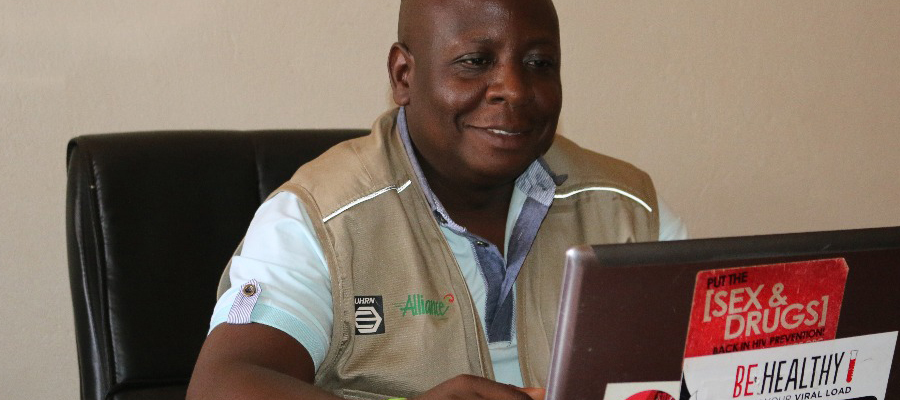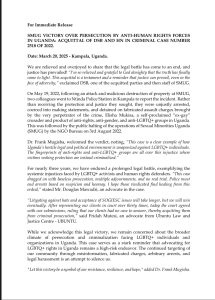Uganda Harm Reduction Network (UHRN), a youth led drug user initiative was established in 2008 to respond to the drug user crisis in Uganda. The network strives to advocate for practical interventions aimed at supporting and addressing issues of people that use and inject drugs. The network also seeks to provide a national platform for health and policy programs that promote good practices and advocate for supportive environment for the adoption, implementation and expansion of harm reduction programs for People Who Use and Inject Drugs (PWUIDS) in Uganda.
Kuchu Times visited UHRN office premises in Kampala to learn about their work with PWUIDS ; we spoke to Mr. Wamala Twaibu who took us through the network’s operations across the country.
Mr. Twaibu says the number of Ugandans who use and inject drugs has increased overtime, something that has escalated the cases of violence and human rights abuses committed by law enforcement agencies through blackmail and extortion. This has made it hard for many drug users to access basic health services.
UHRN was registered in 2014 and currently the network comprises twenty six organisations in seventeen districts. UHRN focuses on human rights and public health approach and Mr Twaibu testifies that these two core approaches have helped them register some remarkable achievements.
Like any other affected population groups, drug users face a variety of challenges. “Drug users are highly discriminated even within the umbrella of key populations themselves. People thought and still think that drug users are useless people who have no future, but a drug user is a son, a daughter and a member of a certain family. I think every family has a drug user and we have discovered that PWUIDS cut across, you find a drug user who is MSM, transgender, heterosexual, lesbian, bisexual or a sex worker,” he explained.
UHRN has done work across all spheres from grass root, national to international level where they have conducted numerous studies. For instance, they recently concluded a research in Mbale and Kampala where they discovered that HIV prevalence rate among people who use drugs is 21% and women are the most affected category. The general percentage of HIV prevalence among drug users in the thirteen districts where UHRN operates is at 45%.
“In the UHRN database, we have a total of over five thousand people who inject drugs and ten thousand five hundred who use other substances like sniffing, smoking and other categories of drugs. Those who are more inclined to sniffing and injecting are usually urban based,” Mr Twaibu revealed.
In terms of government response to PWUIDS and UHRN advocacy, Mr Twaibu says the biggest challenge they have faced is government looking at these people as criminals who do not deserve to be supported.
“To avert this, we have been taking our gospel beyond Ministry of health, Uganda AIDS Commission, Butabika Psychiatric Hospital and lobbying international bodies. The government is slowly realizing,basing on the data coming from the studies we are conducting, the need to intervene. They have just very recently given us a go ahead to demonstrate the needle and syringe exchange program to prevent HIV in four districts of Mbarara, Kampala, Mbale and Gulu, the targeted districts under the Global Fund,” Mr Twaibu further revealed.
On their projects with other key population groups, Twaibu believes that issues of drug users cut across all categories of key populations and because of this, UHRN has a number of engagements with other constituencies like sex workers, LGBTI and other groups in order for them to understand that reducing harm cuts across all the marginalised groups and should be addressed collectively.
“I am a former drug user and had I been discriminated against, then we wouldn’t be here advocating for the rights of these people. There were people who believed in my recovery and made sure I got back on the right tyrack- this is something that can happen for every drug user if we believe in and encourage them,” Twaibu said.
Legally, the Narcotic Drugs and Psychotropic Substances (Control) Act -NDPSA 2015 makes it difficult for drug users to have instruments like needles and syringes or narcotics since this can be used as evidence to charge them in court. The Act criminalizes the possession of these drug-usable apparatus with a fine of approximately $3,000 or imprisonment of a minimum of ten years. The war on drugs has negative implications for individual users of drugs who are harassed, forced to hide, and regarded as unapprehended criminals.
We also talked to Juliet,the Communication and Gender Officer at UHRN and she expounded on the network’s projects directed at helping female drug users. She said female drug users encounter many social problems such as gender based violence with most cases of intimate partner violence handled at UHRN facility and most of these are driven into this by their partners who abuse them psychologically, physically, emotionally and sexually-all this has led to high levels of HIV infections.
Twaibu calls upon families of people who use and inject drugs to support one another. “Issues of drugs are issues of health so don’t look at these people as hopeless but rather as people who need help and support. Drug use or addiction is a public health issue not a criminal issue,” Twaibu concluded.




